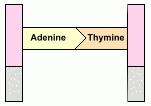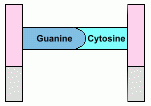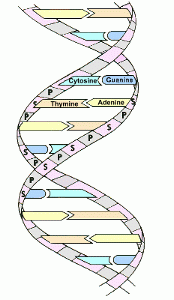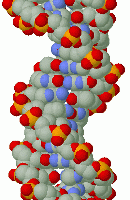 Page Two The nitrogen bases that stick out from each nucleotide in DNA nucleic acid are one of four molecules: adenine, thymine, guanine, and cytosine. What makes these molecules special is that each can attach itself to only one of the other nitrogen bases. In particular, adenine can attach only to thymine, and guanine can attach only to cytosine.   Because a long nucleic acid molecule is within a cell where there are plenty of enzymes, nucleotides, and other molecules floating around, a second nucleic acid molecule can be built that contains nucleotides in a pattern that will attach itself to the original. Every adenine sticking out will attach to a corresponding nucleotide with thymine, every thymine sticking out will attach to an adenine, every guanine will attach to a cytosine, and every cytosine to a guanine.
 A DNA molecule actually looks more like the diagram on the left. The two nucleic acid strands are entwined around each other, forming a double spiral, or double helix shape.
A DNA molecule actually looks more like the diagram on the left. The two nucleic acid strands are entwined around each other, forming a double spiral, or double helix shape.  Keep in mind that our diagram is just a representation of the molecule. Each of its parts is actually composed of a uniquely organized grouping of atoms. A segment of DNA might be more accurately pictured as in the diagram on the right, where individual atoms are visible.
Keep in mind that our diagram is just a representation of the molecule. Each of its parts is actually composed of a uniquely organized grouping of atoms. A segment of DNA might be more accurately pictured as in the diagram on the right, where individual atoms are visible.
DNA is a molecule with some very useful properties. First of all, the sequence of millions of nucleotide pairs forms a unique pattern for that particular organism. No other organism will have a pattern that is exactly the same ... there are just too many different arrangements. The number of different patterns for a DNA molecule with 1 million nucleotide pairs is 41,000,000 Secondly, this pattern is like a code ... it contains information. The pattern of nucleotide pairs in an organism is not random, but has been created carefully over time to perform various functions. Different arrangements in the DNA's surface molecules can attract and bond to other molecules, creating proteins which which will detach and build cell structures, or become part of larger enzyme molecules that perform other functions in the organism. In fact, the DNA molecule is so long and contains so many smaller patterns for constructing other molecules that the information it contains descibes the complete formation and growth of the organism and all its systems. As DNA is passed from an organism to its offspring, nothing is ever discarded. Some segments may cease to function as portions are damaged by mutations, or are superceded by more dominant portions, but segments are never thrown away. Moreover, beneficial mutations may cause the some parts of the DNA pattern to perform new functions that help the organism survive better. This is natural selection. But this process causes the organism to change, or evolve, over many millions of years, as the functions of various parts of the DNA change. The consequences are remarkable, from a molecular point of view. As some organisms change, and parts of their DNA perform new functions, the old unused patterns in the DNA remain. We'll show you what this means by considering the example of chimpanzees and humans. Many tens of millions of years ago there was a creature that lived in various parts of the world. The changing environments in different locations caused different segments of the population of creatures to change, in different ways, to better survive in their particular locale. Eventually the different segments evolved into other organisms, and they in turn continued to evolve. Humans can trace their origins back to one of these branches, and chimpanzees to another. The DNA within both chimpanzees and humans, however, while changing slightly by adding new functions, still contains the DNA patterns from the original organism. Moreover, some of the original patterns are still used ... after all, both humans and chimpanzees are fur-bearing warm-blooded creatures with four appendages that bear live young. We can see our close relation to chimpanzees by examining human and chimp DNA, where we discover that 98% of the pattern in each is identical! Now let's look at how DNA can reproduce itself. Move on to page three >>> |
